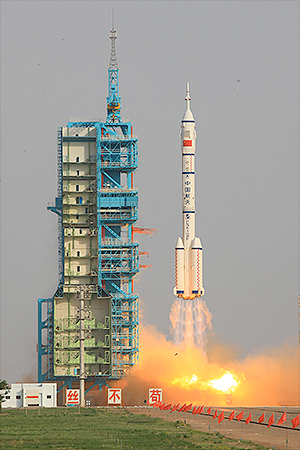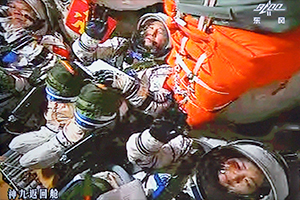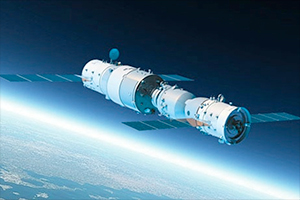June 16, 2012 — China on Saturday (June 16) launched its fourth manned spaceflight — including the nation's first female astronaut — on a mission to perform the country's first piloted docking with a prototype space station.
The Shenzhou 9 capsule lifted off at 6:37 a.m. EDT (1037 GMT) on top of a Long March 2F rocket from the Jiuquan Satellite Launch Center in northwest China's Gobi desert. Flying on the spacecraft were three Chinese astronauts, or "taikonauts" — Jing Haipeng, Liu Wang and Liu Yang.
Jing, the mission commander, previously flew on China's third spaceflight, Shenzhou 7, in 2008. Saturday's launch was the first for Liu Wang and Liu Yang, the latter making history as the country's first woman in space.
China had held off naming the Shenzhou 9 crew members until the day before they launched. A backup crew, which included Shenzhou 6 flight engineer Nie Haisheng, Zhang Xiaoguang and Wang Yaping, the only other woman in the Chinese astronaut corps, was seen preparing for the flight alongside Liu and her two crewmates, which added to the worldwide speculation as to who would be the first female taikonaut in space.
Liu is the 56th woman to fly into space out of the more than 500 people that have flown into orbit worldwide. The world's first woman in space, Soviet cosmonaut Valentina Tereshkova launched in 1963, 49 years to the day before Liu's mission began.
"I am grateful to the motherland and the people," Liu Yang said in a press conference held on Friday (June 15). "I feel honored to fly into space on behalf of hundreds of millions of female Chinese citizens."
Docking demonstration
The Shenzhou 9, or 9th "Divine Vessel," mission is aimed at demonstrating the skills and techniques required before China can deploy its planned space station in the coming years. The Shenzhou crew will fly their capsule through an autonomously-controlled rendezvous and docking with the Tiangong-1 module, an unmanned lab that was launched in September 2011.
Once the two spacecraft are linked, two of the Shenzhou crew members are expected to enter the Tiangong, or the "Heavenly Palace," to perform science experiments, while the third tends to the flight systems aboard the Shenzhou. The taikonauts will then separate their Shenzhou from the module to attempt a piloted docking before undocking from Tiangong-1 again to return to Earth for a mission duration of about two weeks.
"The launch of the Shenzhou 9 is a highly influential event that marks an important milestone for the development of China's space technology," said Cui Jijun, director of the Jiuquan Satellite Launch Center, before the launch.
Shenzhou 9 is the second spacecraft to visit Tiangong-1. In November 2011, China sent the unmanned Shenzhou 8 spacecraft to the module, which under autonomous control successfully caught up to and connected with the space lab twice during a nearly 17 day mission.
Milestone mission
The Shenzhou 9 mission marks a milestone for China's human spaceflight program, which began in 2003 with the solo flight of taikonaut Yang Liwei on board the Shenzhou 5 spacecraft. The nation flew two astronauts on Shenzhou 6 in 2005 and demonstrated its first spacewalk three years later.
The third nation to put a human into space, China intends to be the third nation to deploy a space station by 2020.
"The implementation of [a] space rendezvous and docking mission, as well as the breakthrough and mastering of rendezvous and docking technology are the basis and premise for the construction of manned space station," a spokesperson for the Manned Space Engineering Office said last year. "It is of great significance for the realization of [the] China Manned Space Engineering Project and the promotion of sustainable development of manned space flight."
China plans to send one more crewed flight to Tiangong-1, next year's Shenzhou 10, before de-orbiting the space lab module and pushing forward with its station plans. |
|

The Long March-2F rocket carrying China's crewed Shenzhou 9 spacecraft launches from the Jiuquan Satellite Launch Center in northwest China's Gobi desert, June 16, 2012. (Xinhua)

Video still showing the Shenzhou 9 crew aboard their spacecraft. From left, Liu Wang, Jing Haipeng and Liu Yang. (Xinhua)

Artist rendition of China's Shenzhou 9 spacecraft docked with the Tiangong-1 orbiting space lab module. (ATCM) |
